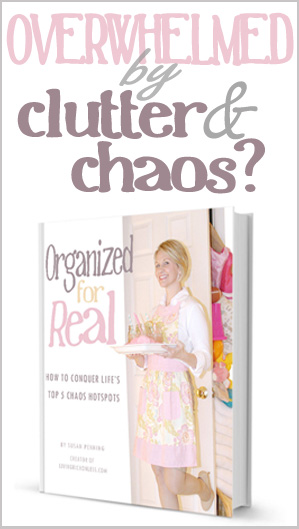Garden labels from paint stir sticks
Has spring got you thinking about a garden yet? Well, if you’ve been following this blog for awhile, you know I have a bit of a brown thumb. So although I’ve given up on planting a full vegetable garden (for now), I still like to plant a few kitchen herbs every year. I especially love basil (Caprese salad, anyone?) and cilantro, although I’ve found growing cilantro to be a little tricky. (Any tips on keeping it alive are much appreciated.)
To keep everything straight, I like to use garden labels made from paint stir sticks. You know, the free wooden ones you get when you buy a can of paint.
I trim them in half or thirds using my miter saw. I only do thirds if I believe I can cut them without losing any fingers. 😉 Then I give them a quick coat of chalkboard paint, front and back.

While the labels dry, I plant my herbs, usually in some sort of container.
 Finally, I add the chalkboard paint stir sticks, using a chalkboard marker to label each plant. Done!
Finally, I add the chalkboard paint stir sticks, using a chalkboard marker to label each plant. Done!
 If I don’t touch or breathe on them too much, hopefully this year’s plants will survive. I love using fresh herbs in my dishes, don’t you?
If I don’t touch or breathe on them too much, hopefully this year’s plants will survive. I love using fresh herbs in my dishes, don’t you?







Love this Susan. I will be using this for my entire garden. Thanks!
Glad it was helpful, Michelle. 🙂
Great idea Susan. I’ve used the paint sticks too for labeling but didn’t paint them. In the garden, I have used white thin pvc pipes cut in short lengths to label rows, and where my asparagus comes up each spring, I know exactly where the roots will shoot up the spears; so I know where to look for growing plants. With a magic marker, I can label the pvc pipes where my vegetable rows have seeds planted, or simply trim a corner of the seed packet and slip it over the top of the pvc pipe at the beginning of each row, and place a pvc pipe at the end of the row to mark the row.
For keeping the plants alive, don’t over water, but keep moist, and never let get dry as a bone. Keep it in sunlight or partial sunlight, yet these type of plants only live for a season. You can let them go to seed and collect your own seed and restart, or simply, just go to Wal-Mart and replace the plant. Hardy parsley can be kept inside during the winter, but you always have to check the plants for tiny pests before bringing any plant in from outdoors, so you don’t infect other indoor plants. This are my experiences learned from my past knowledge from working in a greenhouse and from 40 plus years of gardening on my own.
Soooo cute Sus!